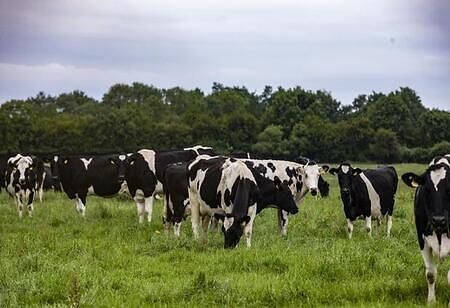
Dairy Farming is Gaining Momentum in Karnataka


It was the Grama panchayath secretary of a village in Gadag district, Karnataka, who actually triggered the transformation of Mallanna and his family's life, which once stared at poverty in its evil eyes. Mallanna belongs to the scheduled caste category, and he is ill. His kids are two and four years old, so his wife can’t go out for work, leaving the three at home. As the family belongs to the ST category, the officer suggested they do cattle farming, as they have one acre of land to grow grass for the cattle. He told them about the Pashu Bhagya scheme for scheduled caste and tribe category people, where they get one cow free and a loan for farming cows. The family was beyond pleased. They started to do cattle farming, which today has become a full-time occupation for them.
Every family belonging to SC/ST category and backward classes can benefit from the Pashu Bhagya scheme; all you need is determination and courage.
All about Pashu Bhagya Scheme
The Pashu Bhagya scheme came into light in 2015- 2016, launched by the Government of Karnataka. Under the scheme, people who belong to SC/ ST category can get a loan of up to Rs.1.20 lakh from commercial banks with up to 50 percent subsidy. Besides, farmers from backward classes and the general category can also benefit from the scheme, as they are provided with a 25 percent subsidy. Insurance benefits up to Rs. one lakh are provided for livestock farming. Farmers can also insure five cattle for the amount. Insurance coverage for cows will be at Rs. 5,000 per animal.
The scheme is formulated under central government schemes such as the Dairy Entrepreneurship Development program (DEDS) and National Livestock Mission (NLM). Under the scheme, the government releases the subsidy will in the back-ended form to the banks. Besides, all the beneficiaries under dairying should compulsorily come under the milk routes of Milk Producers’ Cooperative Societies formed under the Karnataka Milk Federation. Beneficiaries should get membership in Milk Producers Cooperative Societies. The government will inform local milk producers’ cooperative societies to have a Memorandum of Understanding with the concerned banks to help the farmers repay the loans. Framers will have to attend the training programs to understand the subsidy and the breeds of cows they can farm.
How to Apply for the Pashu Bhagya scheme
People can visit a nearby veterinary center and get the application form, and they have to submit mandated documents such as caste income and identity certificate. Now the government is accepting online applications as well.
Markets for the Framers to Sell Milk and Milk Products
Karnataka Milk Federation, the apex body of the state government of Karnataka, encourages dairy development activities as well as stimulates the farmers to sell their products in the dairy. The aim of the federation is to avoid third-party involvement so that the farmers can get the price for their products accordingly. According to the reports, the dairy market has reached Rs. 798.7 billion in 2021.
What Breeds of Cows Will Produce More Yield for Farmers?
Gir Breed: The Gir breed is also called Bhadawari, Desan, Gujarati, Kathiawari, Sorthi, and Surati. Originated from Gir forests, south Kathiawar in Gujarat, the Gir cows, usually have white skin with red or chocolate brown patches on them. The breed is famous for disease resistance and hardiness. This breed will give milk of about 1200 to 1800 kgs per lactation, depending on the location.
Red Sindhi: As the name suggests, the cows will have red or dark red skin color with stripes on the skin. These breeds are heat tolerant as well as disease resistant. The milk yield is high according to the regions.
Jersey: This breed will be smaller in size compared to the other breeds. In our country, Jersey cows are used in crossbreeding with indigenous cows. The government suggests these cows because the milk yield from this breed of cows will be about 4500 kg per lactation, according to the locations. And the fat content of the milk will be 4.5 percent. Jersey cows are somewhat heat-sensitive.
Holstein Friesian: This breed is one of the largest dairy breeds because the cow's mammary gland will be huge, so the yield will also be around 6500 kg according to the locations. The breeds are distinguishable as they have typical markings of black and white on their skin.
Success Stories
Laksmi Bhai, a woman who belongs to the SC category in a village on the outskirts of South Karnataka, had two acres of land where she grew Amla (Gooseberry). As soon as she learned about the Pashu Bhagya scheme, she applied for a loan and got seven cows. It was a bit difficult for her to manage the cows in the beginning. But she made real use of the training organized by the government, and she was quickly able to get the highest yield of milk. The increased income motivated her to expand her farming.
Currently, Lakshmi Bhai has ten cows in her farm and produces 80 liters of milk daily. By selling the milk at the rate of Rs.25 per liter, she is able to get an income of about Rs. 60,000 per month, not to mention the additional benefits of selling manure.
She has employed two laborers from the village to look after the cows. After meeting all the expenses, Lakshmi's annual income from dairying is about four lakhs per annum. In truth, dozens of people from the villages in Karnataka have succeeded in cattle farming and living a better life by leveraging the Pashu Bhagya scheme.